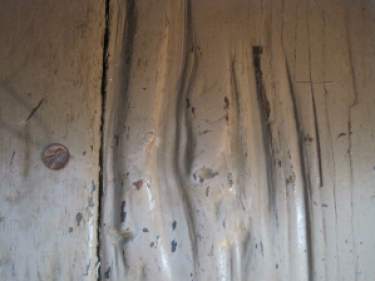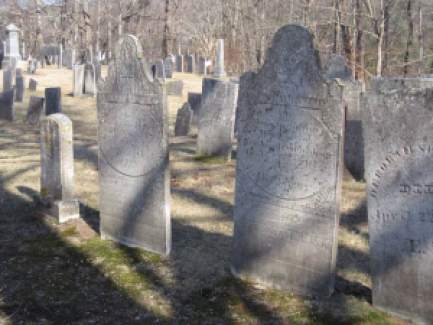After Josiah Spaulding, Jr. was chained to the floor in his room in about 1812 by his minister father, he would never again live a life unfettered by his father’s religious and patriarchal control—a control which extended over the Spaulding family long after the Reverend’s death in 1823.
Oral history of Buckland tells the tale of Josiah’s early escape attempt: he rubbed his chains against the wooden floor in his bedroom for about a year, finally breaking them. This story is recorded in Neil Perry’s 1966 article for the Springfield Morning Union. While there is much sensationalism in any newspaper article written about Josiah, my trip to the Spaulding house in Buckland in 2012 led me to believe this had actually happened.
After some research, I managed to locate the owner of the former parsonage, built in the late 1700s, the home of Reverend Spaulding, Mary Williams and their children. There has been very little restoration or modernization done to the former Spaulding home. I was invited there by its owner at the time, Edward Purinton, whose family goes back two hundred years in the Buckland area. Ed grew up in Josiah’s room and his mother had been a local Spaulding researcher. She collected funds from the community to install a gravestone for Josiah in the churchyard cemetery alongside his family, for Josiah, who died at the Deerfield Poor Farm, was buried in an unmarked grave.
Ed told me that the room was very cold in the winter, and in the letters, Josiah’s sisters often expressed concern that he stayed warm enough. Josiah’s bedroom still had the original wide-plank floors, the type of which is no longer seen in the United States. Ed moved the bed out of the way, and there underneath were the chain grooves made by young Josiah, who had been chained in front of the fireplace.
The grooves in the floor where Josiah scraped his chains.
According to legend, Josiah managed to break his chains after he rubbed them into the wooden floor. He escaped from his bedroom out the back staircase, which was situated very close to his bedroom and would have been easily reached. The original hardware was still on the doors of the house, and Josiah’s bedroom only had a latch—typical hardware of the late 1700s in this region. The back staircase did indeed open to the kitchen, where the back door was about a foot away. The barn was also very close to the house; here, Josiah attempted to take the family horse and ride to freedom. According to oral history, a neighbor commandeered Josiah and brought him back to the Reverend. Next door to the Spaulding house is an early nineteenth century house that would have been there in 1812. Josiah’s sister Lydia is said to have alerted her father of his escape, and in the commotion, the neighbor came out to tackle Josiah.
The villagers of Buckland were all aware of what had happened to Josiah; they knew that he was “insane,” and that the Reverend was keeping him chained up. It may be hard to believe that the villagers did not think of it as abusive, but at this time, they did not view it that way. Instead, church records and biographies of Reverend Spaulding refer to his “affliction,” his punishment from God: his son, Josiah Jr. Just like epidemic disease in this era was not understood to be biological in nature, mental illness was believed also to be something that God put upon a family. These afflictions were not anyone’s business to interfere with, especially not if it was the family of the highly revered local minister. Reverend Spaulding spoke from the pulpit about what had happened with his son and his version of events is what everyone believed, although it is unclear exactly what he may have said. Whatever he said, it did not elicit sympathy for Josiah. The sympathy was for the Reverend.
After Josiah’s foiled escape-attempt, Reverend Spaulding knew he had to contain him in something much stronger and harder to escape, so he had an iron cage built by the local blacksmith. In this very small, rural village, the blacksmith and the villagers all would have known exactly for whom they built the cage. It was delivered to the Spaulding home, probably carried there, and strong men assisted the Reverend as they forced his son into it. Once Josiah was put into the cage, his relationship with his sisters and his friends effectively either ended completely or was greatly changed. Letters from Josiah’s friend Ezra Fisk were no longer sent to the Spaulding house and Josiah’s correspondence with his favorite sister, Mary, also ended. The horror and desperation Mary must have felt upon learning that her brother had been put into an iron cage one can only imagine. It most likely only compounded her own feelings of being trapped, isolated, incarcerated in the patriarchal world of the early 1800s in which she could not attend college, work, or be independent of men. There was absolutely nothing Mary could have done about her brother’s situation—and she knew it.
Shortly after Josiah was caged, Mary’s husband Isaac died at age thirty-three from what I suspect may have been cholera or dysentery, when Mary was pregnant with her second child. Their three-year-old daughter also died of disease around the same time. At this time, Mary wrote one of the most heartbreaking letters of the collection to her parents, in which she implored them to help. Mary was entirely alone in Southampton with her second child. Her handwriting was wild, and her tone was of arrant, devastated and hopeless emotion, the kind that occurs only after a remarkable tragedy like what she had experienced: she lost almost everyone important to her in a matter of a few years. Mary had little choice but to return home to Buckland to stay with her parents. Upon her return the family home, she was met with the reality that her brother was now in an iron cage, and that was where he was going to stay for the rest of his life. I do not think that Mary ever recovered from any of these events, and she died at age thirty-nine. None of the Spaulding women survived past the age of fifty.
The Spaulding Family graves
I often wonder if Mary talked to her brother after he was caged, or if he implored her to let him out. The Spaulding daughters and their mother, Mary Williams, were in charge of keeping Josiah clothed, fed and warm. They did his laundry, stoked the fireplace, and cared for him. Josiah was not at all a “raving maniac”; he was not a “lunatic”; and there is no evidence that he was ever “deranged”—whatever those words mean. He was guilty, as his father would have said, of great sin: for being different. He was guilty of running off to Southampton to have fun, of not sharing his father’s Calvinist beliefs, of what may have been possible homosexuality based on the letters that were sent to him by a seemingly infatuated Ezra Fisk. The possible outcome of all of this, as Reverend Spaulding knew, was a challenge to the indomitable religious, patriarchal hold the Reverend maintained over his family and the village. It was such an incredible hold, made stronger by its ultimate physical manifestation in the form of Josiah’s cage, that it continued to socially incarcerate the Spaulding family for decades after the Reverend died. Reverend Spaulding’s death in 1823 around the same time as his wife’s death, did not mean a release or reprieve for Josiah, who by then was in his forties. The next generation cared for him, in his cage, as Josiah was transported up the hill to his sister Lydia’s house after the death of his parents. He was taken from the cage, his limbs long atrophied, carried up the hill by villagers, some of whom also carried his cage, in a grim procession to his destination at the home of Lydia. They lived right across the street from the First Congregational Church of Buckland, where the Reverend had preached for twenty-eight years. In its shadow, Josiah would live out the second half of his adult life.
Disability history is imperative to the field of Disability Studies, especially when there is primary source material like Josiah’s letters. In this case, a researcher can analyze his life in a more direct fashion, and also can learn from the letters of his family. If we were to read only newspaper articles and biographies of Reverend Spaulding and Josiah, we might come to the conclusion that Josiah really was violent and deranged, and that his poor father had no other choice but to cage him. Understanding that people with psychiatric and other disabilities are often very intelligent, observant, caring and nonviolent people is imperative to creating and fostering a world where disabled people like Josiah are given the resources they need to achieve contribute to what Disability Studies scholar Rosemarie Garland Thomson would call a biodiverse world. Diversity amongst humans and perspectives of those who think differently or experience the world differently are an important part of fostering intellectual development for all humans. Presuming the competence of those with disabilities, as former Syracuse University Dean of the School of Education, Douglas Bicklen, would say, is a great way to start the process of biodiverse societal inclusion. Josiah’s letters clearly disprove presumptions of derangement, being “lower than a brute” and “insensate.” However, portrayals of psychiatric disability from the nineteenth century and before have continued to create stigma and bias today. Understanding the history of these perceptions and biases and where they began is necessary to unravel them, and see—really see, without presumption —the lives and experiences of disabled people now and in the past.
The cover photo is the room where Josiah was kept.
Kate Corbett Pollack is a graduate student in Cultural Foundations of Education and Disability Studies at Syracuse University. Her scholarship has grown from Josiah’s story, and has led to an interest in prisons, mental illness, social reform, education and disability. She wrote a monthly blog for almost three years, which can be viewed at americanpomeroys.blogspot.com, the blog for the American Pomeroy Historic Genealogical Association. She has also written for and done work with the Landmarks Society of Greater Utica on the history and families who lived in a few of the beautiful old mansions in that area. Prior to coming to the university, she lived in Brooklyn, and before that Eugene, Oregon where she was born, and Utica, New York. Her family in Syracuse goes back one hundred years, and she has lived here over the years on occasion.



